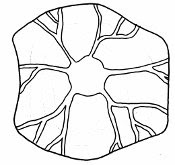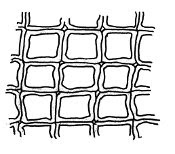Plants possess three main tissue groups: GROUND, VASCULAR, and DERMAL.
PARENCHYMA CELLS - These are 'typical cells'. Most common type of cell and tissue. Progenitors of all other tissues. Form bulk of most edible foods.
Function - bulky packing material; sites of food storage (e.g.starch, oil); mechanical support (when turgid) in herbaceous plants; gaseous exchange; transport of materials through cell walls (aerenchyma); photosynthesis (chlorenchyma); plus virtually all other metabolic processes in plant; can become meristematic when injured or damaged, forming a cork cambium – extremely important for recovery from adverse conditions (this property is used in propagation).
Where Found - cortex of roots; pith of stems; leaf mesophyll; medullary rays in wood; packing tissue in xylem and phloem. Cell Shape - basically round, but appear polyhedral when in contact with other cells; large vacuole and nucleus.
Cell Shape - basically round, but appear polyhedral when in contact with other cells; large vacuole and nucleus.
Cell Wall Material - thin primary wall only, composed of: cellulose; pectins; hemicelluloses.
Cell Status - alive
Function - support; because it is so flexible, plants can grow upwards and compete for light.
Where Found - often as long strands near stem surfaces and along midrib of leaf; strings of celery (petiole of leaf) composed of collenchyma. Cell Shape - elongated and polygonal with tapering ends.
Cell Shape - elongated and polygonal with tapering ends.
Cell Wall Material - primary wall only, thickened at corners to provide support; composed of cellulose, pectins, hemicelluloses; cells tightly-packed together.
Cell Status - alive.
SCLERENCHYMA CELLS - present as FIBRES; SCLEREIDS. Each has both primary cell wall and a thick, lignified secondary wall (gives support). Cells are non-living at maturity and lack protoplasts.
FIBRES
Function - support; strength; protection.
Where Found - outer regions of cortex; pericycle of stems; xylem and phloem; abundant in wood and bark of flowering plants; occur in strands or bundles (e.g. flax, hemp, jute) Cell Shape - elongated and polyagonal with tapering, interlocking ends.
Cell Shape - elongated and polyagonal with tapering, interlocking ends.
Cell Wall Material - mainly lignin; cells start off as normal cells with cellulose walls, but as lignin (which is impervious to air and water) is laid down, cell suffocates and dies leaving hollow ligin fibres with tapering ends.
Cell Status - dead.
Function - support; mechanical protection (e.g. seed coat).
Where Found - cortex; pith; phloem; common in shells of nuts; pits of stone fruits (e.g. cherries, peaches); give pears their gritty texture.
 Cell Shape - roughly spherical or irregular.
Cell Shape - roughly spherical or irregular.Cell Wall Material - mainly lignin - also cellulose; hemicellulose; pectins.
Cell Status - dead.
VASCULAR TISSUE SYSTEM
2 types: xylem and phloem - these form the plant's 'plumbing system' - may be primary or secondary in origin.
XYLEM - Occurs as TRACHEIDS (found in all xylem tissue) or vessel VESSEL MEMBERS (found in flowering plants (angiosperms), not in conifers); tracheids also sometimes present in angiosperms, but always in conifers (gymnosperms)). Fibres and parenchyma cells also present.
Function - conducts water and dissolved mineral salts from roots to leaves and stems; also provides structural support.
Where Found - embedded in ground tissue; runs continuous system through whole plant.
Cell Shape - TRACHEIDS are long, tapering cells with overlapping ends; water passes from one tracheid to another through pits - thin areas in tracheids' cell walls where a secondary wall did not form.
TRACHEIDS are long, tapering cells with overlapping ends; water passes from one tracheid to another through pits - thin areas in tracheids' cell walls where a secondary wall did not form. VESSEL ELEMENTS are hollow, but unlike tracheids, they have holes in their end walls called perforations - these might be completely dissolved away, giving easy passage to water; vessel elements stack (like barrels) on top of each other to form ELEMENTS, which also have pits; wider than tracheids, so more efficient.
VESSEL ELEMENTS are hollow, but unlike tracheids, they have holes in their end walls called perforations - these might be completely dissolved away, giving easy passage to water; vessel elements stack (like barrels) on top of each other to form ELEMENTS, which also have pits; wider than tracheids, so more efficient.
Cell Wall Material - Thick walls, mostly lignin. Like sclerenchyma fibres, they start life as living cells containing cellulose, pectins and hemicellulose. As lignin (impervious) is laid down in cell walls, cells lose contents and die, leaving hollow lignified tubes.
Cell Status - dead at maturity (though parenchyma cells are live)
PHLOEM - Consists mainly of unlignified living cells called SIEVE TUBES, adjacent COMPANION CELLS, fibres and parenchyma.
Function - sieve tubes, with help of companion cells, transport organic solutes (food) throughout plant.
Cell Shape -
SI EVE TUBES are long and tubular (comprised of stacked SIEVE TUBE ELEMENTS). Ends of cell walls connected by perforations called SIEVE PLATES.
EVE TUBES are long and tubular (comprised of stacked SIEVE TUBE ELEMENTS). Ends of cell walls connected by perforations called SIEVE PLATES.
COMPANION CELLS are long and narrow and possess nuclei and all other components of a normal cell.
Cell Wall Material - Both types have normal composition: cellulose; hemicellulose; pectins.
Cell Status - living.
DERMAL TISSUE SYSTEM- epidermis and periderm
 EPIDERMIS - Consists mostly of parenchyma cells. Leaf epidermis impregnated by GUARD CELLS and STOMATA (pores). Apart from guard cells, no chlorophyll is present, so epidermis is transparent. To prevent damage and water loss, epidermal cells of stems and leaves are covered by a waxy layer of cutin, called the CUTICLE.
EPIDERMIS - Consists mostly of parenchyma cells. Leaf epidermis impregnated by GUARD CELLS and STOMATA (pores). Apart from guard cells, no chlorophyll is present, so epidermis is transparent. To prevent damage and water loss, epidermal cells of stems and leaves are covered by a waxy layer of cutin, called the CUTICLE.
Function
Provides a covering ('skin'), usually one cell thick, over primary plant cell body to prevent water loss and protect against infection. Hairs and glands have various functions e.g. root hairs increase absorptive area of roots; others cut down water loss, or provide defence (nettle). Cell Shape - as parenchyma (leaf epidermal cells have wavy edges fitted together like a jigsaw; guard cells sausage-shaped with thin outside walls).
Cell Shape - as parenchyma (leaf epidermal cells have wavy edges fitted together like a jigsaw; guard cells sausage-shaped with thin outside walls).
Cell Wall Material - cellulose; hemicellulose; pectins; cutin
Cell Status - living.
PERIDERM - Cork layer. Formed by CORK CAMBIUM, it makes up bark and replaces epidermis in older woody plants.
Function - Protection and prevention of water loss; LENTICELLS (loose groups of cells) allow aeration. Cell Shape - cells small and spherical as they develop; later SUBERIN, a fatty substance, laid down in walls, making them impervious to water and air; hairs and glands have various shapes.
Cell Shape - cells small and spherical as they develop; later SUBERIN, a fatty substance, laid down in walls, making them impervious to water and air; hairs and glands have various shapes.
Cell Status - dead.
No comments:
Post a Comment